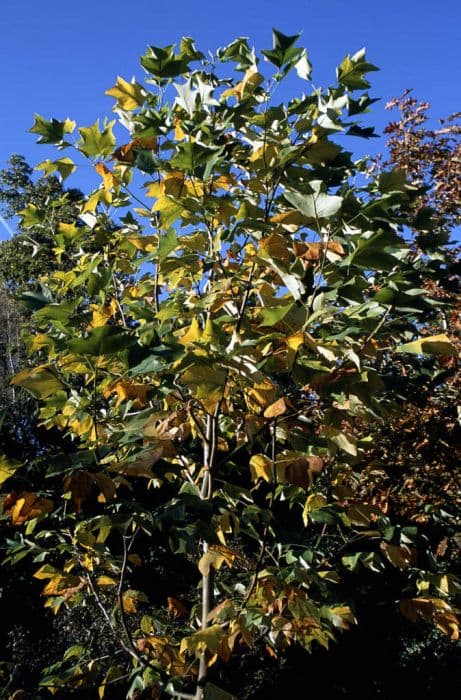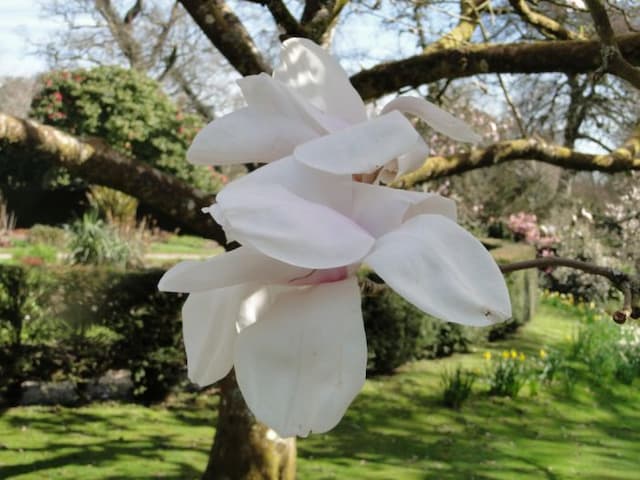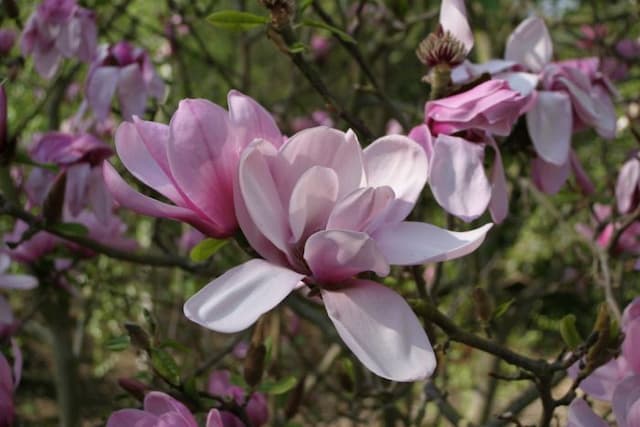Star Magnolia Magnolia stellata 'Water Lily'

ABOUT
The Magnolia stellata 'Water Lily' is a captivating plant recognized by its beautiful, star-shaped flowers. The flowers are breathtaking, boasting multiple narrow petals that are pure white to sometimes having a slight pink blush, especially at the base. They have a rich, sweet fragrance that is especially noticeable in the early spring, which is when this plant typically blooms. The leaves of the 'Water Lily' magnolia are a glossy deep green, providing a stunning backdrop to the bright blossoms. In the fall, the leaves turn a bronzy color before shedding for the winter. This contrast of flower and foliage makes it a highly ornamental plant throughout different seasons. As its flowers mature, they gracefully open up to resemble the shape of a waterlily, which is where this variant gets its name. The buds themselves are also quite showy, being a silky, fuzzy texture that hints at the softness of the petals within. Overall, the 'Water Lily' magnolia is a picture of grace and delicate beauty, known for its striking floral display which adds elegance to any garden landscape where it's grown.
About this plant
 Names
NamesFamily
Magnoliaceae
Synonyms
Star Magnolia, Water Lily Magnolia
Common names
Magnolia kobus var. stellata, Magnolia stellata 'Rosea', Magnolia stellata 'Royal Star'.
 Toxicity
ToxicityTo humans
Star magnolia is generally not considered toxic to humans. There are no well-documented cases of poisoning from ingesting this plant. However, it is generally advisable not to eat ornamental plants due to the unknown effects and potential for pesticide contamination.
To pets
Star magnolia is not known to be toxic to pets. While it is not common for pets to ingest this plant, and there are no significant reports of poisoning, it's always best to prevent pets from eating ornamental plants as they can cause gastrointestinal upset or other health issues unrelated to toxicity.
 Characteristics
CharacteristicsLife cycle
Perennials
Foliage type
Deciduous
Color of leaves
Green
Flower color
White
Height
4 feet [1.2 meters]
Spread
4 feet [1.2 meters]
Plant type
Shrub
Hardiness zones
4
Native area
Japan
Benefits
 General Benefits
General Benefits- Ornamental appeal: The plant is highly valued for its decorative white or pink flowers that resemble water lilies, which can enhance the aesthetic of any garden or landscape.
- Seasonal interest: Magnolia stellata 'Water Lily' typically blooms in early spring, providing an early burst of color and interest after the winter months.
- Attracts wildlife: The flowers may attract pollinators such as bees and butterflies, promoting biodiversity in the garden.
- Compact size: This cultivar has a smaller stature, making it suitable for gardens with limited space or for use in residential landscaping.
- Low maintenance: Once established, it generally has low maintenance requirements, needing only occasional pruning and watering during prolonged dry periods.
- Drought resistance: It has some level of drought tolerance, making it suitable for climates with occasional water restrictions.
 Medical Properties
Medical PropertiesThis plant is not used for medical purposes.
 Air-purifying Qualities
Air-purifying QualitiesThis plant is not specifically known for air purifying qualities.
 Other Uses
Other Uses- Magnolia stellata can be used in bonsai cultivation. Its attractive flowers and manageable size make it a beautiful choice for the art of bonsai.
- The wood of Magnolia stellata is sometimes utilized in woodworking for small projects, such as inlays and decorative objects, due to its fine grain and texture.
- This plant's dried seed pods can be used in floral arrangements to add an unusual and interesting texture to the composition.
- The star magnolia's bark has been traditionally used in tanning, imparting a unique fragrance to the leather.
- Its flowers can be used to make a fragrant, floral-scented syrup for use in desserts or cocktails.
- The petals of Magnolia stellata can be candied and used as an elegant decoration for cakes and pastries.
- The plant can serve as a living sculpture in gardens due to its striking form and the way it holds snow on its branches in winter, offering an aesthetic value beyond its blooming season.
- Magnolia stellata branches are flexible when young and can be used in the crafting of wreaths and other botanical art pieces.
- The fibers from Magnolia stellata can be incorporated into handmade paper, giving it a unique texture and appearance.
- Dried leaves of the star magnolia can be used to create natural mulch or compost for garden beds, providing nutrients and improving soil structure.
Interesting Facts
 Feng Shui
Feng ShuiThe Star Magnolia is not used in Feng Shui practice.
 Zodiac Sign Compitability
Zodiac Sign CompitabilityThe Star Magnolia is not used in astrology practice.
 Plant Symbolism
Plant Symbolism- Purity: The white blooms of the Star Magnolia symbolize purity and innocence.
- Dignity: The imposing presence of the Star Magnolia is often associated with dignity and nobility.
- Perseverance: As an early bloomer, the Star Magnolia represents perseverance in the face of adversity, as it blooms boldly even in colder climates.
- Beauty: Its stunning flowers are indicative of beauty and splendor, often relating to the natural beauty of a person’s character or the aesthetic beauty in life.
- Nature's Balance: The balance between its sturdy structure and delicate flowers symbolizes the balance of strength and grace in nature.
 Water
WaterStar Magnolia trees should be watered deeply once a week to help establish their root systems. During particularly dry periods, watering frequency may need to be increased to twice a week. Provide about 2 gallons of water per session for young trees, ensuring it reaches the roots and doesn't just wet the surface. Once established, they are more drought tolerant and may require less frequent watering, depending on rainfall and soil conditions. Adjust watering in the winter when the tree is dormant, as it will need less water during this time.
 Light
LightStar Magnolias thrive in full sun to partial shade. The ideal spot would provide morning sunlight with some afternoon shade, especially in hotter climates. It's important to protect them from harsh afternoon sun to prevent leaf scorch.
 Temperature
TemperatureStar Magnolia trees prefer temperate climates and can tolerate a range of temperatures from about -20 to 90 degrees Fahrenheit. They are cold-hardy down to USDA zone 4. The ideal temperature range for promoting good growth and flowering is between 60 and 75 degrees Fahrenheit during the growing season.
 Pruning
PruningPrune Star Magnolia trees to maintain shape and remove any dead or diseased wood. This is best done after they bloom in spring but before mid-summer to avoid cutting off next year's buds. Generally, pruning once a year is sufficient, but it may not be necessary every year if the tree's shape is pleasing and healthy.
 Cleaning
CleaningAs needed
 Soil
SoilStar Magnolia thrives in acidic to neutral soil, pH 5.0-7.0, with rich organic matter. A mix of peat, loamy soil, and compost is ideal for ensuring good drainage and fertility.
 Repotting
RepottingStar Magnolia is typically not a container plant and does not require repotting. When planted in ground, it grows best without disturbance.
 Humidity & Misting
Humidity & MistingStar Magnolia prefers moderate humidity but is adaptable to normal outdoor conditions, without the need for specific humidity adjustments.
 Suitable locations
Suitable locationsIndoor
Star Magnolias are not ideal for indoor growing; they require outdoor conditions to thrive.
Outdoor
Plant in well-drained, acidic soil with sun to part shade and shelter from strong winds.
Hardiness zone
4-8 USDA
 Life cycle
Life cycleStar Magnolia 'Water Lily' begins its life as a seed, which, when conditions are suitable, will germinate to establish a root system and a shoot that emerges from the soil. As a young plant, it focuses on leaf and root development to establish a robust foundation for future growth. The plant then enters a vegetative growth stage, developing woody stems and foliage, and with proper care and maturity, it starts to form distinctive star-shaped flowers that are usually white or pink and appear in early spring before the leaves. After pollination, typically by insects, the flowers develop into cone-like fruit that releases seeds once mature. Once the plant reaches maturity, it continually cycles through periods of growth, flowering, and seed production unless interrupted by environmental conditions or human intervention. Eventually, as the plant ages, its growth slows, and it may succumb to diseases, pests, or environmental stresses, completing its life cycle.
 Propogation
PropogationPropogation time
Late winter-early spring
The Star Magnolia 'Water Lily' is commonly propagated through hardwood cuttings. This technique is best performed in late fall, after the tree has gone dormant, or in early spring before bud break. To propagate, select a healthy, mature branch, and cut a piece about 6 to 8 inches (15 to 20 centimeters) long, making sure it includes at least 2 to 3 nodes. Dip the cut end in rooting hormone to encourage root development. Place the cutting in a well-draining soil mix, ensuring that several nodes are buried. The cutting should then be kept moist and out of direct sunlight until roots have developed and new growth is observed. This method has the advantage of producing a mature clone of the parent tree, maintaining its desirable characteristics.









![Magnolia [Felix Jury]](/_next/image?url=https%3A%2F%2Fplants-admin.emdemapps.com%2Fimages%2Fplants%2F%2Fimages%2F604b61a0b23b7.png&w=640&q=75)